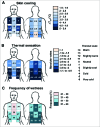Human skin wetness perception: psychophysical and neurophysiological bases
- PMID: 27227008
- PMCID: PMC4843859
- DOI: 10.1080/23328940.2015.1008878
Human skin wetness perception: psychophysical and neurophysiological bases
Abstract
The ability to perceive thermal changes in the surrounding environment is critical for survival. However, sensing temperature is not the only factor among the cutaneous sensations to contribute to thermoregulatory responses in humans. Sensing skin wetness (i.e. hygrosensation) is also critical both for behavioral and autonomic adaptations. Although much has been done to define the biophysical role of skin wetness in contributing to thermal homeostasis, little is known on the neurophysiological mechanisms underpinning the ability to sense skin wetness. Humans are not provided with skin humidity receptors (i.e., hygroreceptors) and psychophysical studies have identified potential sensory cues (i.e. thermal and mechanosensory) which could contribute to sensing wetness. Recently, a neurophysiological model of human wetness sensitivity has been developed. In helping clarifying the peripheral and central neural mechanisms involved in sensing skin wetness, this model has provided evidence for the existence of a specific human hygrosensation strategy, which is underpinned by perceptual learning via sensory experience. Remarkably, this strategy seems to be shared by other hygroreceptor-lacking animals. However, questions remain on whether these sensory mechanisms are underpinned by specific neuromolecular pathways in humans. Although the first study on human wetness perception dates back to more than 100 years, it is surprising that the neurophysiological bases of such an important sensory feature have only recently started to be unveiled. Hence, to provide an overview of the current knowledge on human hygrosensation, along with potential directions for future research, this review will examine the psychophysical and neurophysiological bases of human skin wetness perception.
Keywords: body temperature regulation; humidity; hygroreceptors; hygrosensation; mechanoreceptors; nervous system; perception; skin; temperature; thermoreceptors.
Figures






Similar articles
-
Peripheral and central determinants of skin wetness sensing in humans.Handb Clin Neurol. 2018;156:83-102. doi: 10.1016/B978-0-444-63912-7.00005-9. Handb Clin Neurol. 2018. PMID: 30454611 Review.
-
Why wet feels wet? A neurophysiological model of human cutaneous wetness sensitivity.J Neurophysiol. 2014 Sep 15;112(6):1457-69. doi: 10.1152/jn.00120.2014. Epub 2014 Jun 18. J Neurophysiol. 2014. PMID: 24944222
-
Neurophysiology of Skin Thermal Sensations.Compr Physiol. 2016 Jun 13;6(3):1429. doi: 10.1002/cphy.c150040. Compr Physiol. 2016. PMID: 27347898 Review.
-
Evidence for the involvement of peripheral cold-sensitive TRPM8 channels in human cutaneous hygrosensation.Am J Physiol Regul Integr Comp Physiol. 2020 Mar 1;318(3):R579-R589. doi: 10.1152/ajpregu.00332.2019. Epub 2020 Jan 22. Am J Physiol Regul Integr Comp Physiol. 2020. PMID: 31967850
-
Thermosensory mapping of skin wetness sensitivity across the body of young males and females at rest and following maximal incremental running.J Physiol. 2019 Jul;597(13):3315-3332. doi: 10.1113/JP277928. Epub 2019 Jun 2. J Physiol. 2019. PMID: 31093981
Cited by
-
E-Skin: The Dawn of a New Era of On-Body Monitoring Systems.Micromachines (Basel). 2021 Sep 10;12(9):1091. doi: 10.3390/mi12091091. Micromachines (Basel). 2021. PMID: 34577734 Free PMC article. Review.
-
Tactile cues significantly modulate the perception of sweat-induced skin wetness independently of the level of physical skin wetness.J Neurophysiol. 2015 Jun 1;113(10):3462-73. doi: 10.1152/jn.00141.2015. Epub 2015 Apr 15. J Neurophysiol. 2015. PMID: 25878153 Free PMC article.
-
The biology of skin wetness perception and its implications in manual function and for reproducing complex somatosensory signals in neuroprosthetics.J Neurophysiol. 2017 Apr 1;117(4):1761-1775. doi: 10.1152/jn.00883.2016. Epub 2017 Jan 25. J Neurophysiol. 2017. PMID: 28123008 Free PMC article. Review.
-
Time, touch and temperature affect perceived finger position and ownership in the grasp illusion.J Physiol. 2018 Jan 15;596(2):267-280. doi: 10.1113/JP274781. Epub 2017 Dec 18. J Physiol. 2018. PMID: 29082527 Free PMC article.
-
The role of human thermoregulation in thermal discomfort in lower-limb prosthetics: A scoping review.Can Prosthet Orthot J. 2025 Mar 28;8(1):43073. doi: 10.33137/cpoj.v8i1.43073. eCollection 2025. Can Prosthet Orthot J. 2025. PMID: 40904915 Free PMC article. Review.
References
-
- Gagge AP. A new physiological variable associated with sensible and insensible perspiration. Am J Physiol 1937; 120: 277-87.
-
- Candas V, Libert J, Vogt J. Human skin wettedness and evaporative efficiency of sweating. J Appl Physiol Respir Environ Exerc Physiol 1979; 46: 522-8; PMID:438022 - PubMed
-
- Nadel ER, Stolwijk JAJ. Effect of skin wettedness on sweat gland response. J Appl Physiol 1973; 35: 689-94; PMID:4770352 - PubMed
-
- Havenith G, Bröde P, den Hartog E, Kuklane K, Holmer I, Rossi RM, Richards M, Farnworth B, Wang X. Evaporative cooling: effective latent heat of evaporation in relation to evaporation distance from the skin. J Appl Physiol (1985) 2013; 114: 778-85; PMID:23329814; http://dx.doi.org/10.1152/japplphysiol.01271.2012 - DOI - PubMed
-
- Havenith G. Individualized model of human thermoregulation for the simulation of heat stress response. J Appl Physiol (1985) 2001; 90: 1943-54; PMID:11299289 - PubMed
Publication types
LinkOut - more resources
Full Text Sources
Other Literature Sources
